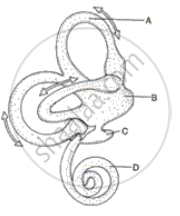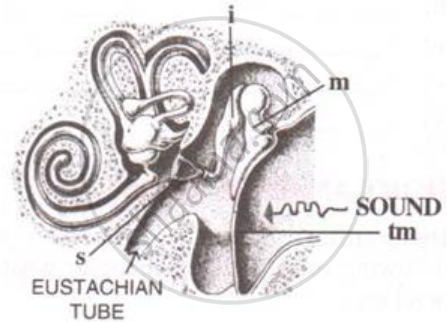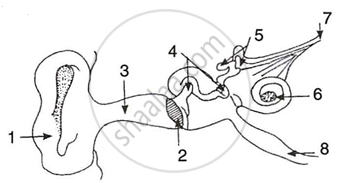Advertisements
Advertisements
प्रश्न
The diagram alongside represents the structure found in the inner ear. Study the same and then answer the questions that follow:
(i) Name the parts labelled A, B, C and D.
(ii) Name the parts of the ear responsible for transmitting impulses to the brain.
(iii) Name the part labelled above which is responsible for:
1. Static equilibrium. 2. Dynamic equilibrium. 3. Hearing
(iv) Name the audio receptor cells which pick up vibrations.
(v) Name the fluid present in the inner ear.

उत्तर
(i) A - Semi-circular canal
B - Utriculus
C - Sacculus
D - Cochlea
(ii) Auditory nerve.
(iii) 1. Utriculus and sacculus
2. Semi-circular canal
3. Cochlea
(iv) Sensory cells of organ of Corti
(v) Perilymph
APPEARS IN
संबंधित प्रश्न
The number of oscillations per second of a vibrating object is called its time period.
State the main function of the Suspensory ligament of the eye
Give scientific reasons: We cannot distinguish colours in moonlight.
Note the relationship between the first two words and suggest the suitable word for the fourth place.
sound : ear drum :: Dynamic balance : ……
Where is the Cochlea located? Briefly mention its function.
With reference to the human ear, answer the question that follow:
Name the part of the ear associated with
(1) static balance
(2) hearing
(3) dynamic balance.
With reference to the human ear, answer the question that follow:
Name the nerve, which transmits messages from the ear to the brain.
Mention the exact location of the following :
Incus
Name the nerve which carries electrical impulses from the cochlea of ear to the brain.
Why should we not put a pin or pencil in our ears ?
Write whether the following is true or false:
Vitreous chamber is present in ear in humans.
The figure below is the sectional view of a part of the skull showing a sense organ:

What are the parts labeled 'm', 'i' and 's'? What do these parts constitute collectively?
Given below is the diagram of the human ear. Study the same and answer the questions that follow:

(i) Give the biological term for the part labeled ‘A’ and state its function.
(ii) Name the part labeled ‘B’ and state its function.
(iii) Name the part labeled ‘C’ and state its function.
(iv) Give the function of ear wax.
The part of the ear that collects the sound from the surroundings is ______.
Give reason:
Three small bones of ear ossicles are advantageous as compared to one single bone for hearing.
With reference to human ear answer the question that follow:
Name the part of the ear associated with Static balance.
- Draw a neat and well labelled diagram of the membranous labyrinth found in the inner ear.
- Based on the diagram drawn above in (i), give a suitable term for each of the following descriptions:
- The structure responsible for hearing.
- The sensory cells that help in hearing.
- The membrane-covered opening that connects the middle ear to inner ear.
- The nerves that carry impulses from the ear to the brain.
- The tube which equalises the air pressure on either side of the ear drum.
The figure given below shows the principal parts of a human ear. Study the diagram and answer the following questions.
 |
- Label the parts 1 to 8.
- State the role of parts 6, 7 and 8.
- Why is it harmful to use a sharp object to remove ear wax? Mention the number and name of the part involved.
